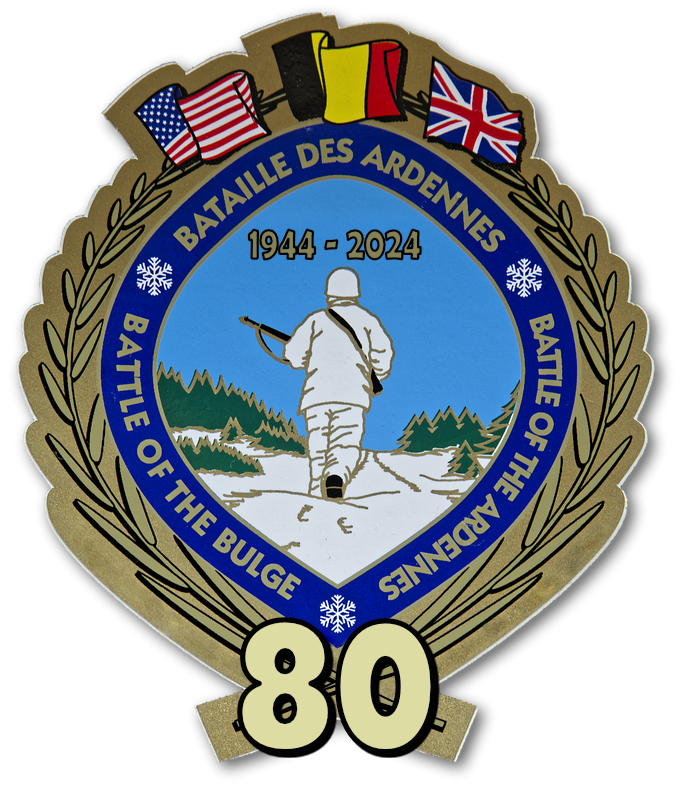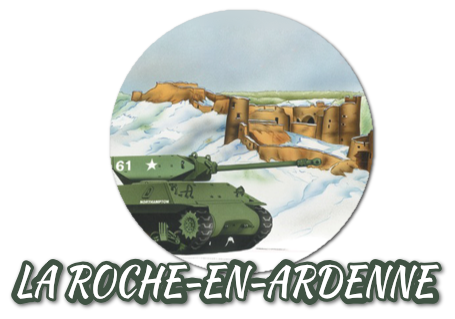Histoire de La Roche dans la Bataille des Ardennes
It’s during the night of December 18 to 19 that the first troop movements are seen in the vicinity of La Roche.

On December 19th, the advanced elements of the 116th Panzer Division circle Houffalize and arrive in Bertogne at noon. In the evening they arrive in view of the Ortheuville bridge where they run into the American 705th battalion of tank destroyers on its way to Bastogne.
Having heard that Houffalize was not occupied by the Americans the 116th Panzer decide to return there for the night.
On December 20th, the 116th Panzer Division takes Samree and important stocks of food and fuel left by the 7th U.S. Armoured Division – All the vehicles of the 116th can refuel.
On that same day, after a discussion with General Hodges, Marshal Montgomery decides to counter attack with the 3rd Armoured Division of General Rose, the 84th Infantry Division of General Bolling and the 4th Cavalry Group.
The 3rd Armoured Division arrives in Hotton and General Rose sends out three task forces: task force Kane to Manhay, task force Tucker to Samree via Amonines and Dochamps and task force Hogan to La Roche via Trinal, Beffe and Cielle.
The 84th Infantry Divisions spreads out along the Marche to Hotton ridge.
General Rose wants to take Samree back as soon as possible and orders Tucker to advance. He sets off at 10.30 p.m. but does not even succeed in entering Dochamps on the road to Samree. After taking Samree the 116th Panzer had moved on to Dochamps and occupied the village.
General von Waldenburg, commander of the 116th Panzer is ordered to take the road from Soy to Hotton and its bridge over the Ourthe and to make a dash towards the Meuse in the north-west.
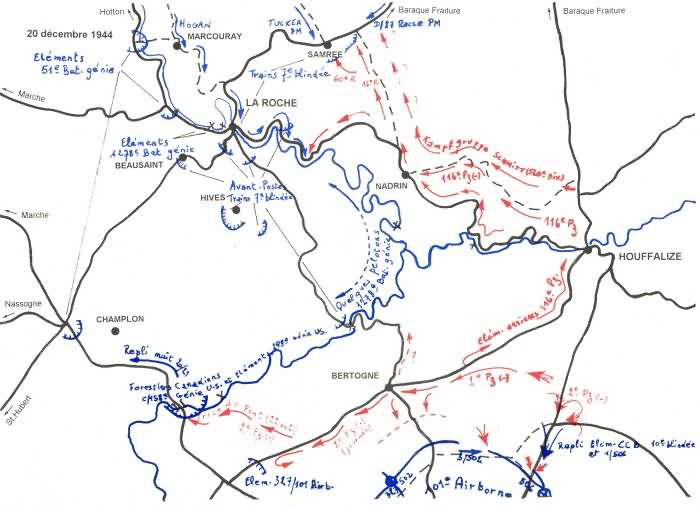
On December 21st, at 5 a.m., the 116th Panzer which has progressed all night, has taken the villages of Devantave, Magoster, Wy and Mélines. The 116th goes for Hotton but the 3rd Armoured Division puts up a valiant resistance and holds them back for two days. This attack by the 116th will however oblige task force Hogan to take refuge in Marcouray.
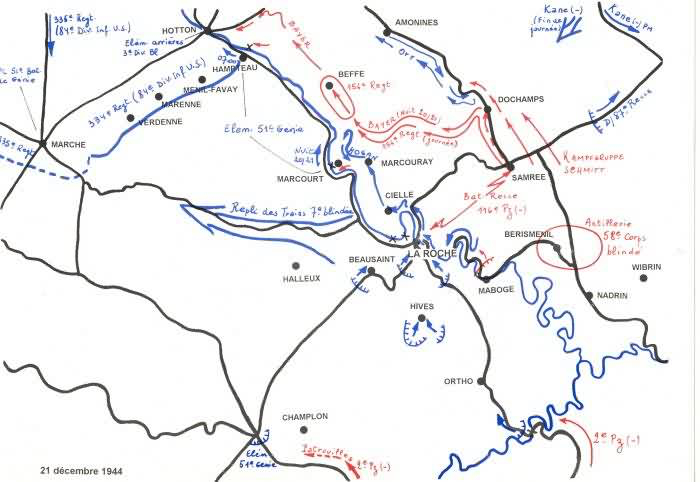
On December 22nd, heavy snowfall slows down all troop movements.
On December 23rd, the German command orders the 560th Volksgrenadier Division to take over from the 116th Panzer Division stopped in front of Hotton. This will allow the 116th to attack from the other side, using the bridge in La Roche to cross the Ourthe.
It’s freezing and the sky is clear. This will finally allow the allied airforce to take part in the battle.
On the northern bank, facing the 3rd Armoured Division is the 506th Volksgrenadier Division and on the southern bank, facing Verdenne, the 116th Panzer Division is opposed to the 84th Infantry Division.
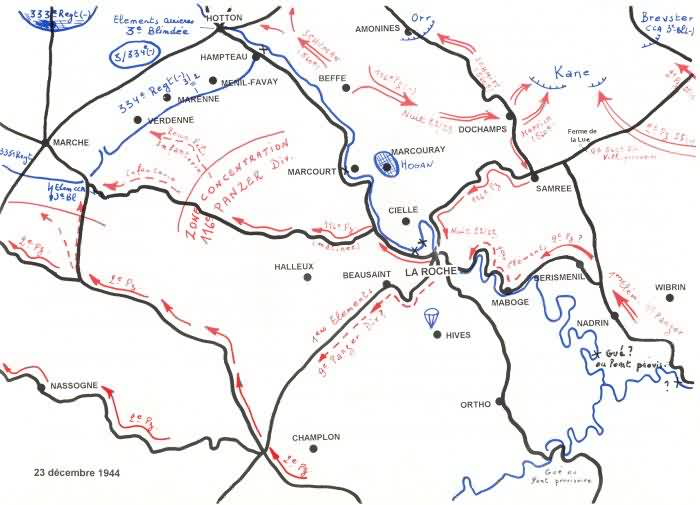
On December 24th, following the attacks by the American aviation to help task force Hogan in Marcouray, the 506th Volksgrenadier has to abandon the ridges to the east of the village.
The 116th Panzer attacks Verdenne and reaches the high ground above Bourdon.
The 75th Infantry Division is sent to reinforce the 3rd Armoured Division near Hotton.
On December 25th, its a sad Christmas with no truce anywhere. All forces in presence continue their fight relentlesly.
Colonel Hogan and his group who are still encircled in Marcouray decide to leave on foot during the night of 25 to 26 December. They made it back to the American lines. The group of 400 men made it back with the loss of only one man, shot by a nervous American sentry.
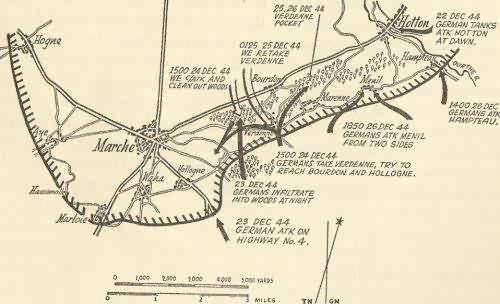
On 26 December, the Führer Begleit Brigade arrives to reinforce the 116th Panzer. While the 116th continues its attacks on Verdenne the Führer Begleit Brigade attacks Hampteau and Menil-Favay.
In the evening however the 116th Panzer is obliged by the 84th Infantry Division to abandon Verdenne and the Führer Begleit Brigade is ordered to stop its advance and to rejoin the siege of Bastogne without delay. It was on the point of taking Hampteau.
The strange order received by the Führer Begleit Brigade came directly from Hitler himself who had just heard that Patton’s 3rd Army had entered Bastogne and he wanted to re-establish the siege without delay.
This order was to cost the German army. Due to lack of fuel the tanks of the Führer Begleit Brigade broke down one after the other and most of them would never reach Bastogne.
On 27 December, the 12th SS Armoured Division arrives in the region of Samree with elements of the 2nd SS Armoured Division and attack in the direction of Amonines, Sadzot and Forge à la Play. The attack does not succeed and the German troops take up defensive positions.
In La Roche the population is suffering allied artillery shelling as well as two bombardments aiming to get rid of the German anti aircraft guns on the high ground around La Roche.
The Town Hall gets a direct hit and as TNT demolition charges, destined for the bridge, was stocked in its cellars, the whole group of houses around it was blown.

On 30 December the 12th SS Armoured Division is ordered back to Bastogne to take part in a pincer attack on the corridor into Bastogne held by the Americans.
On 31 December, the 12th SS Division sets out to rejoin Bastogne using two roads, one through Houffalize and the other through La Roche.
On January 1st, La Roche is bombarded by the allies at the cost of many houses and civilian lives.
On January 3rd, the VII U.S. Corps attacks from Hotton to Manhay with the River Ourthe on its right, the River Aisne in the middle and the Liege-Houffalize road on the left. General Collins places his forces on either side of the Aisne: The 2nd Zrmoured Division and the 84th Infantry Division on the right. On the left, the 3rd Armoured Division and the 83rd Infantry Division. Behind them, in reserve, the 75th Infantry Division. The 4th Cavalry Group is placed under the 84th Infantry Division.
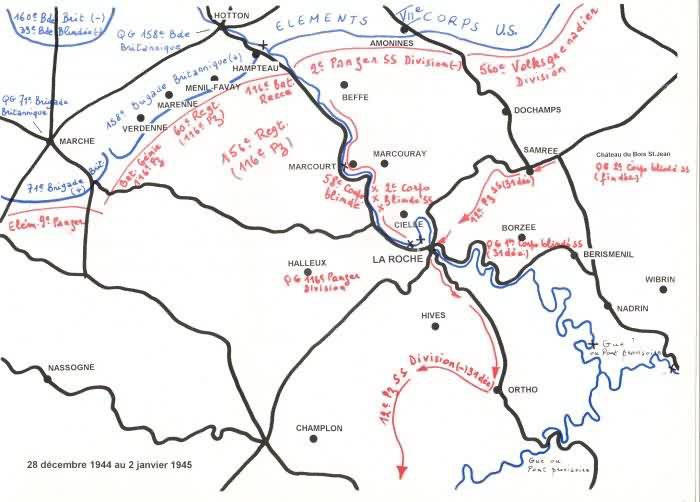
Also on January 3rd, in cold and snowy conditions, the British paratroopers march on Bure that they will liberate after three days of very hard fighting and many losses.
On January 4th, in horrendous weather conditions, the Welsh in turn go forward. By the end of the day, the 53rd Welsh Infantry Division with the 33rd Armoured Brigade attached, are over the Verdenne-Marenne-Menil-Favay ridge and join the Ourthe between Hampteau and Rendeux-Bas.
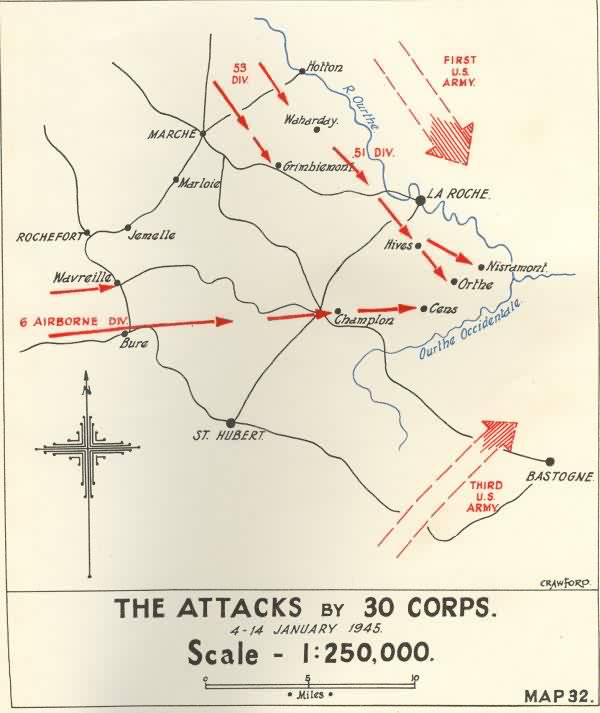
To the west the British 6th Airborne Division with the 29th Armoured Brigade attached, progress in the Direction of Rochefort, Marche, Jemelle and Nossogne encountering tough resistance.
On January 5th, the 84th Infantry Division encounters strong resistance from the 2nd SS Panzer Div. at Concy Ridge all the more so that the Germans have the support of the 116th Panzer shooting from the other side of the Ourthe.
On the British side the 6th Airborne is still blocked in Bure and the 53rd Welsh is stalled.
On January 6th, the situation is stationary on the British side where a deadly battle takes place between the 53rd Welsh and the 116th Panzer in Grimbiemont.
On January 7th, the British advance again, Grimbiemont is taken by an East Lancashire Regiment while Cheoux is takem by the 1st Northamptonshire Yeomanry.
The 1st Battalion of the 334th Regiment (84th Infantry) takes Marcouray and Marcourt.
Dochamps is also taken.
La Roche, still occupied by the Germans, continues to be shelled by the allies.
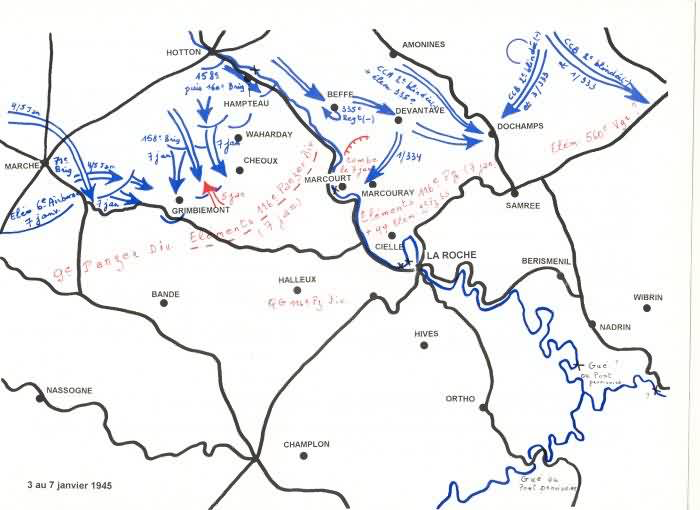
On January 8th, Hitler accepts defeat and authorises a retreat.
On the British side, due to the heavy losses sustained during three days of fighting in the woods, in horrific weather conditions and no rest, the Welsh are replaced by the 51st Highland Division.
So as not to take all their equipment over the icy roads the Welsh leave everything behind for the Highlanders to use.
The Americans take Cielle but meet violent combat in Samrée and only advance by 500 yards.
In La Roche the Germans retreat by the road to Villez and the anti aircraft guns also leave.
On January 9th, the 334th Regiment moves on from Cielle to the Hez de Harzé which is heavily defended by the Germans. 10.000 artillery shells are poured into those woods before the Germans retreat towards La Roche in the evening.
In Samree at nightfall the village is still held by the Germans and 12.000 American shells will fall in the village during the night.
The Americans now hold the road from Vielsalm to La Roche.
In La Roche the German lay mines to protect their retreat.
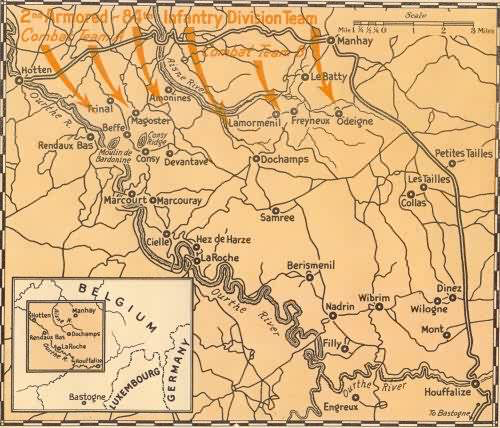
On January 10th, the final assault is launched on Samree by the 2nd Armoured Div helped by the 84th Infantry Div.
On the British side the 6th Airborne reaches Nassogne and the 51st Highland Div. approaches La Roche.
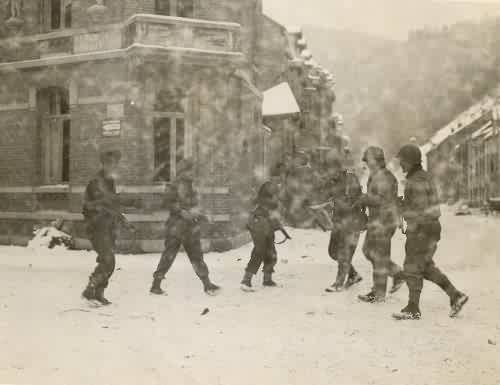
On January 11th, the first elements of the 4th Cavalry Group make their way down from the Hez de Harzé to La Roche that they find abandoned by the Germans. In the same time they see the Highlanders arriving from the other side of the Ourthe.
La Roche is liberated but the battle continues…the Highlanders will still liberate Hives, Hubermont, Mierchamps, Erneuville and Ortho.
Still to be done was to reach Houffalize and link-up with Patton’s 3rd Army.
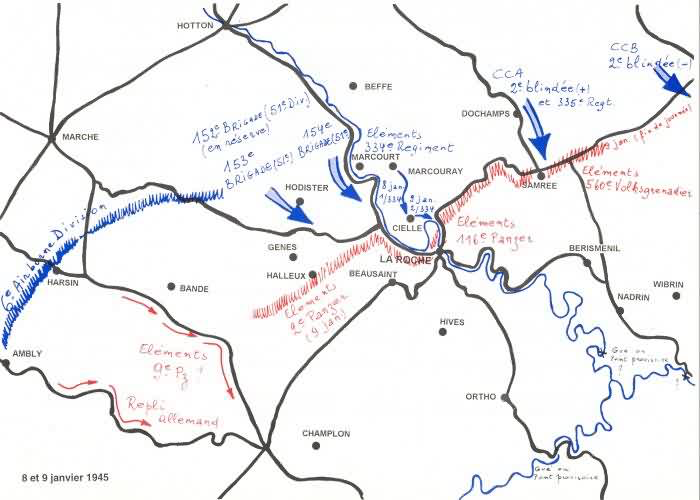
This will be achieved on January 16th at the Rensiwez water mill and bridge. The Bulge has been closed. The fighting will now move on to the east to never return.
The Ardennes have been liberated and can start thinking of rebuilding its destroyed villages.
Sorry, no translation available yet.
Depuis le 22 décembre 1944, la cité rochoise reçoit régulièrement les obus tirés par l'artillerie américaine qui se rapproche. Ces tirs d'artillerie continueront jusqu'au 12 janvier 1945, soit 2 jours après que les Allemands se soient retirés de la ville. Le IXème Bomber Command américain décide de bombarder La Roche dés que les conditions climatiques seront favorables.

La Roche avant la Bataille des Ardennes
L'objectif est de détruire le pont du Faubourg intact. Mais les bombes vont également provoquer de nombreux morts et des destructions parmi les habitations. Le 26 décembre, vers 9 heures, 37 Boston apparaissent au-dessus de la ville et larguent en 2 vagues 75 tonnes de bombes. Le quartier du Faubourg est principalement touché par ce premier raid et le centre-ville est bloqué par les décombres des maisons détruites. Par la suite, les habitants de La Roche subissent de nouveau les bombardements de 38 Boston effectués en 2 vagues. Ils larguent 55 tonnes de bombes sur la cité. Ces raids causent de nouvelles victimes innocentes et d'autres destructions arbitraires. Parmi ces dernières, signalons celle de l'Hôtel de Ville dans les caves duquel avaient été entreposés par les rochois les explosifs destiné à la démolition du pont du faubourg et abandonné en toute hâte par les Américains, lors de l' évacuation du 21 décembre. L'explosion du bâtiment communal provoque l'anéantissement de la place du marché et du quartier de Chanteraine. Le 1 janvier 1945, 26 Bostons larguèrent en deux vagues 37 tonnes de bombes détruisant entièrement les quartiers du Faubourg et du Chalet.

Vue de La Roche après la Bataille des Ardennes
Et de nouvelles victimes sont à déplorer dans la population rochoise. Les dégâts occasionnés à la cité rochoise ont été aussi importants que ceux pour Saint-Vith et plus importants que Houffalize. Malgré un tonnage de bombes larguées nettement plus faible sur La Roche (167 tonnes), contre 1.252 pour Saint-Vith et 1.218 pour Houffalize. Cela est dû en partie à la configuration encaissée de La Roche, où les ondes de choc des explosifs ont résonné sur les flancs des collines, décuplant ainsi leurs effets. La Roche paya un lourd tribut lors de ces bombardements, puisque 114 civils périrent sous les bombes ( la population rochoise était d'environ 500 habitants en cette fin d'année 1944 ) . Sur les 639 maisons que comptait la cité, 348 furent complètement rasées ou gravement endommagées et le pont du Faubourg fût finalement détruit. Après la guerre, la cité fût décorée de la Croix de Guerre avec Palm et depuis ce jour, cette décoration figure sur ses armoiries.
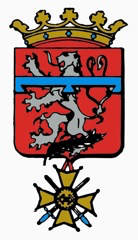

Vue de La Roche après la Bataille des Ardennes
